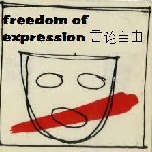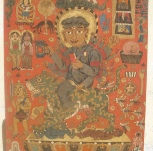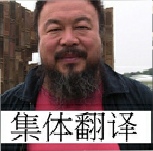


Thoughts on What Has Been Lost
The Painting of Yao Yuan
(Edited and reduced version from the original Chinese text)
Lu Peng
…After her sole exhibition in 2005, Yao Yuan no longer interprets the nature of painting (or art) in a simple way. She not only hopes to find possibilities in her interpretation of landscapes, she also projects her wonder onto such natural objects as flowers, birds, and the branch of a tree. At the same time, rock arrangements, as found in the mansions of southern China, ripples on a pond, and traces of peeling paint, have the power to awaken Yao Yuan’s insights and perceptions. She seeks answers in the transformation and loss of natural objects, ancient calligraphy, and historic heritage. Initially she searched in order to understand herself, but over time she realized that an understanding of this nature was too simple. Gradually, starting with an understanding of others, she sought an understanding of her self. Later, she extended her search, trying to gain insights from every place she’d ever visited; seeking meaning from the air, the sunlight, or a rainy day. It became clear to her that self-understanding is something that deepens with the losses and gains we experience over the passage of time
As scholars have noted, the basic nature of Chinese classics is reminiscence. From reminiscence of the past, one is able to grasp “eternity” and “a state of mind”, i.e. the reminders from Buddha, the muse of literary inspiration, the consciousness awakened by changing nature; even a distant melody. In this sense, Yao Yuan’s brush, ink stone, paper, and ink stick, have become the tools for capturing past memories. The traces left by her brush – a shabby courtyard, Huang Mountain shrouded in mist, and the falling and withering flowers – are things we have come to especially rely on in our quest to recover past memories.
…Yao Yuan does not dwell on the pleasure of playing games with brush and ink, as the literati do. On the contrary, she pours out by means of her brush, feelings derived from various moments in life, i.e. separation, reunion, sorrows, and regrets. Her Garden series can be divided into two themes. One depicts the corner of a garden comprising flowers, grass, and tree branches. The other is about “memory”. These works are inspired by her repeated visits to the gardens of large mansions. Yao differs from other versions of this same theme because she ignores the physical existence of the garden, nor does she pay any attention to the brush-and-ink expression embraced by “New Literati Painters”. It seems that she questions why people fail to note the humble life that springs up in a garden, or the value of existence in a camellia, plum blossom, peach blossom, ancient stalagmite, or even broken branches and withered leaves. The garden is pushed into the background and has only a vague presence. Actually, the garden scene has become a ruin and the composition is broken into fragments. To the eye, they come across as mere clues, reminding us of Time’s passage.
… The Garden Memory series is definitely the result of reminiscence. Although this memory is personal, it actually amounts to a comparison between her experience and old records, as well as ruins. At this level, “memory” has something of a diary quality, but it allows the audience, who reads nothing more than the images on paper, to see more. It is apparent why the following phrase describes the Garden series: “Last night, we finished drinking surrounded by flowers. This morning the stone path was covered with moss.” Time is merciless. Although yesterday was a day of wine, song and laughter; happy moments passed in the company of flowers bathed in moonlight, time has the ability to take this from us and turn it into cold embers. Most of the visitors to the garden walk quickly past the various scenes; few stop to observe the details left by a time that is ever present. However, the painter reveals these details through her own insight: flowers may blossom in profusion on the branches, but eventually they will be destroyed by the cyclic return of night. Perhaps it’s stretching it a bit to say all this will take place in one night, although it’s true that there are some flowers that only bloom for one day. The exact period of blooming is recorded for some plant species in certain environments. Nevertheless, viewers can remain hopeful because the painter always gives “blooming” the most important location in her composition. Experience has taught us that Man’s quest for that which is “unchanging” will never stop, even though we know it means that this beauty must eventually vanish, no matter how reluctant we may be to lose it.
…Yao Yuan’s Huang Mountain series is not the result of her reverence for “virtue” or “indifference to fame and wealth”. She tries to pursue her ideal through nature, by endowing her works with “upright character” and “purity”. There is a minute difference between these two states of mind. The ideals of “virtue” and “indifference towards fame and wealth”, are too bookish, and surely a philosophical poise brought on by disappointment in secular life. Yao Yuan’s pursuit differs from this ideal. However, that doesn’t mean she didn’t look into the thoughts of ancient people, or that she is free from day to day troubles of her own. Rather, she is hoping that her tireless pursuit of beauty will enable her to smooth out her melancholy and sadness. It is easy to see why Yao Yuan likes snowy mountains. Snow symbolizes “upright character”, which is exactly the goal she is trying to achieve. She hopes to return again and again to the snowy mountains she has visited in the past, no matter if they be in the western regions, or Huang Mountain. It does not matter which mountain. What is important is the “purity” that derives from these natural mountains can purify the grime and impurity of one’s heart. It is a spiritual need for people who are tired of bustling daily life and try to put all their problems behind them.
…Starting with her series, Changping Scroll of Paintings, Yao Yuan began looking into the thoughts of the ancients, observing nature, and to express her insights through her painting. She has common sense, but now with life changing so rapidly, she needs a deeper understanding of all of life’s problems. The basic philosophy in Snowy Mountain in Autumn is not much different from the Changping Scroll of Paintings. She has simply condensed the scroll of paintings into a small scale version. She has placed flowers, birds, tree branches, and snowy mountains shrouded in mist, into a somewhat dramatic space. We can also see that the painter has unified her varied brush-and-ink techniques previously applied in several different subjects and areas. In her series of Screen paintings, Yao Yuan emphasized spatial arrangement. The painter has had several years of experience in design, and this has helped her grasp the idea of space arrangement without being trapped in traditional concepts. With great assurance she separated the different scenes of mountains surrounded in mist into several “screen panels”. She wants viewers to compare and explain the different feelings they experience upon viewing each screen, for example the different emotions one feels when viewing the paintings of Jian Jiang and Mei Qing. Even so, Yao Yuan uses a continuum of mist or cloud to link each natural scene. In truth, what the painter is trying to portray is that the different feelings experienced when viewing natural scenes will all lead to a similar conclusion. The painter simply follows what her heart tells her to do. Yao Yuan even uses a large number of flower blossoms to symbolize nature as it is – life is eternal, although it is presented as a cycle. It is the same idea behind her use of the pine tree motif. After thousands of years of cultural evolution, these natural objects have acquired an undeniable symbolic meaning. As long as we use these symbols well, we will be able to receive the wisdom passed down to us from our ancestors.
Careful examination leads us to declare that The Seventy-two Pictures of Huang Mountain series is the most complete work in Yao Yuan’s various painting collections. She has visited Huang Mountain in every season, going there repeatedly to examine the Huang Mountain paintings of Mei Qing, Shi Tao, and Jian Jiang. Moreover, she kept asking herself what would be her own ideal Huang Mountain. Most importantly, although Jian Jiang’s square rocks shows a special and interesting style, Yao Yuan elaborated them, bringing out the same sadness found in Ni Zan’s painting. The slanting mist, clouds, and thick fog always have an indefinite feeling about them. Since one composition relates with another, it is very difficult for viewers to remain unaffected by the atmosphere these paintings have created. Yao Yuan paid no heed to the beauty of Huang Mountain in the sunlight. Instead, she recorded the vast, indistinct features of Huang Mountain, which had long ago been noted by the people of old. Sometimes, in the sunlight Huang Mountain can look like a group of huge artificial mountains. Those gigantic boulders seem to have been purposely arranged. People who have visited Huang Mountain can easily understand why the people of old included large mountains in their bonsai arrangements. Perhaps the ancients truly felt that the actual size of the mountain did not matter; what really mattered was how we appreciate and understand it. Parts of Yao Yuan’s painting reveal the magnificent peak of Huang Mountain in its entirety. She is determined to cover all of Huang Mountain in an effort to locate something that she feels is present. Her Huang Mountain series has absorbed the transcendental spirit of traditional Literati Painting, but without the excess of sadness and regret that genre favors. This way she successfully side-steps the “New Literati Painting” style, where “pretence” is often seen. It’s impossible to deceive oneself about one’s true state of mind. If one is confident about creating a poetic world, why not go ahead, be oneself, ignore what others say, and pursue it with all one’s might? Even though one may feel sad when we are surrounded by reminders that “beauty soon fades”, Yao Yuan stands her ground. She believes she can scale the pinnacle of the poetic world, and she knows how to go about it. Yao Yuan will depend on her understanding of Nature’s constant change and elusive expression.
… 2005 was the year when she held her solo exhibition and also the year she spent relaxing. She had finished her “passing of time” theme, when she by chance visited a “scared place of Buddhism”. After she came back, she completed the series, One Flower, One World. She painted flower blossoms in various sizes, i.e. plum blossoms, lotus blossoms, peach blossoms, apricot blossoms, and Chinese flowering crab-apple, in front of different niches for Buddhist statues. The manner of arranging the compositions in this series is very unusual. The painter placed two symbols; the blossoming of life and the end of a secular life, together. This attitude more or less shows her challenge to the philosophy of worldliness. It represents a co-existence of two extreme worlds, which can be interpreted as the painter’s thoughts traveling back and forth between these two concepts. Although life does not proceed as one would have wished, it is not an excuse for one to give up the secular life, which is radiant with vigorous force.
…Yao Yuan insisted upon painting flowers; a secular symbol. For example, plum blossoms bloom in October and forecast the coming of winter and death. However, they stand tall in the snow, which seems to be showing their persistent spirit of clinging to life. Maybe it has something to do with the season of birth – spring? The lotus blossom symbol can also be regarded as the painter’s regard for herself. So when the theme, lotus blossom on the snowy mountain, becomes one of her expressions, it is very difficult for us not to think that the painter is pursuing a good and beautiful world. There are many possible interpretations for the story of peach blossoms. However, when it is connected with the mottled niche where Buddhist statues are placed, it indeed strengthens our understanding that beauty is short-lived. The late spring image called forth by the peony, the vitality implied by the apricot blossom, and the gorgeous Chinese flowering crab-apple, each bears a subtle spiritual hint which permits viewers to project their own feelings and interpretations in accord with their experience and understanding. Perhaps Yao Yuan has her own interpretation of flowers. However, when standing before the various Buddhist statues, which advised her to shun the secular world, she is not convinced that their summons is one of absolute good. She seems to hope that the blossoming flowers will reveal “a state of mind”, although those shabby niches, that have failed to withstand time, seem to tell her that the period of bloom, no matter how lovely, is short. Cultivation of character is not something to merely talk about. It cannot be achieved without effort. Nothing is indestructible. Eternity is hidden in the heart of the flowers and the problem is how to understand it.
Translated by Diane Lu and Ronald Brown








